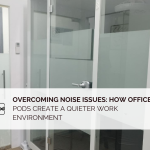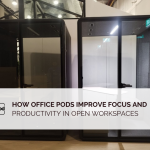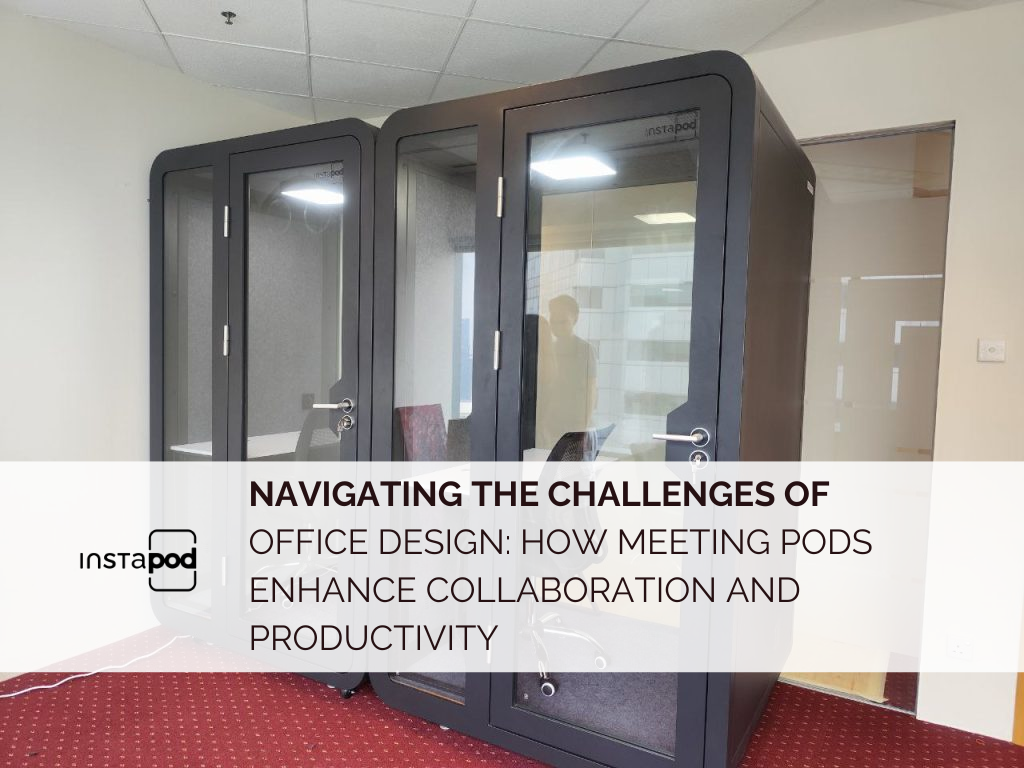No pods added to your quote request yet. Add some now for a free quote!
Navigating the Challenges of Office Design: How Meeting Pods Enhance Collaboration and Productivity

In today’s fast-paced work environment, businesses are constantly searching for ways to boost productivity, enhance collaboration, and create spaces that foster creativity and innovation. However, traditional office designs often struggle to meet these demands. The open-plan office, once hailed as the ultimate solution to workplace efficiency, has faced criticism for its potential to increase distractions and reduce privacy. As a result, companies are exploring alternative solutions, and one that is gaining significant traction is the use of meeting pods.
The Challenges of Traditional Office Design
Open-plan offices were designed to promote interaction, break down hierarchical barriers, and foster a sense of community among employees. However, these benefits often come at a cost. One of the most significant challenges in open-plan offices is noise. The constant hum of conversations, phone calls, and movement can make it difficult for employees to focus on their tasks, leading to decreased productivity.
Moreover, the lack of privacy in open-plan offices can also hinder collaboration. While the idea is to encourage spontaneous conversations and teamwork, the reality is that many employees feel self-conscious about discussing sensitive topics in such an open environment. This can lead to a reluctance to engage in meaningful collaboration, especially when it involves brainstorming new ideas or addressing complex problems.
The Rise of Meeting Pods
Meeting pods offer a solution to these challenges. These self-contained, soundproof spaces are designed to provide a quiet, private environment where employees can focus on their work, collaborate with colleagues, or hold meetings without the distractions of the open office.
Meeting pods come in various sizes and configurations, from small, single-person pods for individual work to larger pods that can accommodate team meetings or brainstorming sessions. Their modular design makes them easy to install and move, allowing businesses to adapt their office layout to meet changing needs.
Enhancing Collaboration
One of the key benefits of meeting pods is their ability to enhance collaboration. In a traditional office setting, finding a quiet space to discuss ideas or work on a project can be challenging. Employees often have to book conference rooms in advance, which can be time-consuming and inconvenient. Meeting pods, on the other hand, are easily accessible and can be used on an ad hoc basis. This flexibility encourages spontaneous collaboration and makes it easier for teams to work together when the need arises.
The privacy offered by meeting pods also promotes more open and honest communication. Employees can discuss sensitive topics without worrying about being overheard, which can lead to more productive and meaningful discussions. This is particularly important in creative industries, where brainstorming sessions often involve the sharing of new and potentially risky ideas.
Boosting Productivity
In addition to enhancing collaboration, meeting pods can also boost productivity. The quiet, distraction-free environment of a meeting pod allows employees to focus on their tasks without the interruptions that are common in open-plan offices. This can be particularly beneficial for tasks that require deep concentration, such as writing, research, or problem-solving.
Meeting pods can also help reduce the stress and fatigue that often come with working in a noisy, chaotic environment. By providing a space where employees can retreat and recharge, meeting pods can improve overall well-being and prevent burnout. This, in turn, leads to higher levels of productivity and job satisfaction.
Supporting Flexibility and Adaptability
In today’s rapidly changing business landscape, flexibility is key. Meeting pods offer a level of adaptability that traditional office designs often lack. Their modular design means they can be easily reconfigured or moved to meet the needs of a growing or changing workforce. This makes them an ideal solution for businesses that want to future-proof their office design and ensure they can continue to meet the needs of their employees in the years to come.
Conclusion
As businesses continue to navigate the challenges of modern office design, meeting pods are emerging as a powerful tool for enhancing collaboration, boosting productivity, and creating a more flexible and adaptable workplace. By providing a quiet, private space for focused work and meaningful collaboration, meeting pods can help businesses overcome the limitations of traditional office layouts and create an environment that truly supports the needs of their employees. Whether you’re looking to improve communication, reduce distractions, or simply provide a more comfortable and productive workspace, meeting pods offer a versatile and effective solution.
Check these out too!
-
 The Role of Meeting Pods in Agile Work Environments: Flexibility and AdaptabilitySeptember 26, 2024/0 Comments
The Role of Meeting Pods in Agile Work Environments: Flexibility and AdaptabilitySeptember 26, 2024/0 Comments -
 How Office Pods Improve Focus and Productivity in Open WorkspacesSeptember 16, 2024/
How Office Pods Improve Focus and Productivity in Open WorkspacesSeptember 16, 2024/ -


